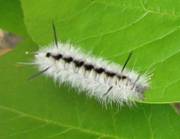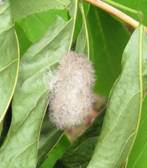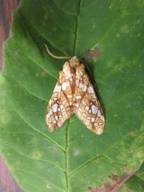DACF Home → Bureaus & Programs → Maine Forest Service → Forest Health & Monitoring → Forest Pest Index → Hickory Tussock Moth
HICKORY TUSSOCK MOTH
Lophocampa caryae
The fuzzy white and black caterpillar of the hickory tussock moth (Lophocampa caryae) feeds on a wide array of hardwood trees. In Maine they have a particular fondness for birch, quaking aspen, basswood and black locust. The caterpillars may strip the occasional tree but in general do little harm to the forest. The caterpillars feed gregariously when they are young and then wander – A LOT – as they get larger and are frequently encountered on the ground, undergrowth and even climbing up siding.
Hickory tussocks are native insects and are found every year, usually in small numbers. Occasionally the numbers will increase to where they are noticed by the general public. The caterpillars are showy and active during the day so they seem like just the cutest thing to play with. Unfortunately their hairy bodies can cause a rash in sensitive individuals.
Once the caterpillars have finished feeding in the fall they spin fuzzy grey cocoons in the leaf litter. These cocoons can also cause a rash so be cautious when raking leaves in a year where the caterpillars have been abundant.
Moths fly in June and July. The females lay their eggs on trees where they hatch and begin feeding. Caterpillars can be found in July, August and September. The winter is spent in the cocoons in the leaf litter on the ground or under bark.



Photos: Hickory tussock moth caterpillar (left), cocoon (middle) and adult (right).
MAINE DEPARTMENT OF AGRICULTURE, CONSERVATION AND FORESTRY
Maine Forest Service - Forest Health and Monitoring Division
October 2011